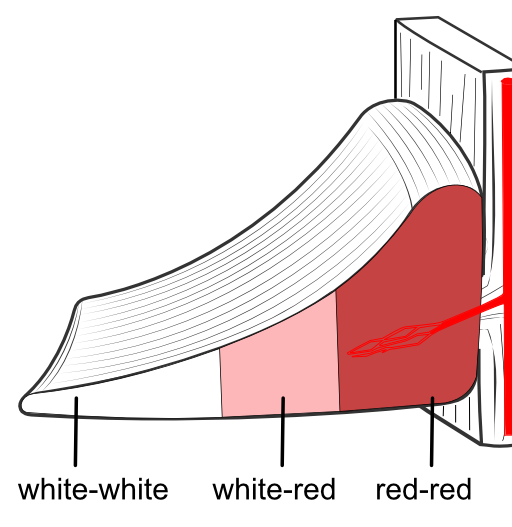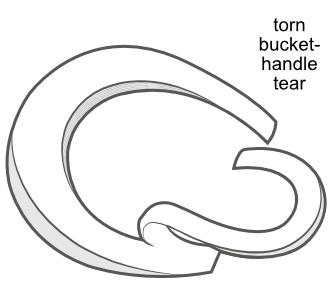The anatomical situation of a meniscus tear, its blood supply and repetitive damage are all factors affecting healing.
 First published in 2011, and reviewed August 2023 by Dr Sheila Strover (Clinical Editor)
First published in 2011, and reviewed August 2023 by Dr Sheila Strover (Clinical Editor)
A number of issues affect how well different meniscus tears heal:
Blood supply of the meniscus

Many of the rehabilitation issues of meniscus tears relate to their blood supply and healing. The meniscus is supplied by a network of tiny blood vessels around the fatter outer rim (the red zone), while the thin inner rim (the white zone) has virtually no blood supply at all, taking its nourishment like a parasite from the joint fluid which bathes the knee joint.
A tear in the red zone ('red-on-red' - implying that both sides of the tear have a good blood supply) has a reasonable chance of healing by itself. If the torn bit is actually surgically repaired then there is a very good chance of healing, particularly if the tear is still fresh.
On the inner thin edge of the meniscus, however, the blood vessels do not penetrate at all. The cells of the meniscus in this region are dependent on any nourishment they can get from the joint fluid. Tears here do not heal. In this area tears are referred to as 'white-on-white' implying a lack of blood vessels on both sides of the tear.
Tears in-between these two regions are referred to as 'red-on-white'. They may heal, but not necessarily.
Recurrent trauma to meniscus

Tears tend to render the knee bio-mechanically unstable and an unhealed tear gets subjected to repeated stress. Tears can propagate, sometimes forming a long loose bit (a 'bucket handle' or a loose flap) which can catch in the joint and lock it, causing damage to the vulnerable joint cartilage it is meant to protect. The larger the tear gets, the greater the alteration in joint mechanics.
The torn fragment may also displace, flipping over and causing 'catching' or 'locking'. This increases damage to the meniscus.
Situation of the meniscal tear
Some anatomical areas are harder to treat than others, such as the anterior and posterior horns. Tears in both areas are frequent and access is difficult. Root tears, root avulsions and ramp lesions have only relatively recently been fully appreciated, and not all knee surgeons have the skills to repair them.
Horizontal tears are also a particular problem - they tend to extend deep into the substance of the meniscus and it is hard to trim to healthy areas without going right to the all-important outer rim. Blood clots may be sewn into the prepared defect or tissue adhesives may be tried. Horizontal tears may also be associated with meniscal cysts.
PREVIOUS PART: Meniscus tears
NEXT PART: Discoid meniscus
